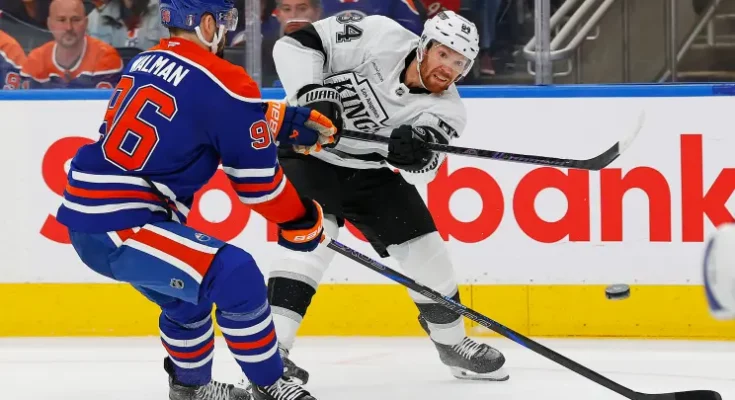When the New York Rangers exited the playoffs last season, one thing was crystal clear to analysts, fans, and even the front office—defensive consistency was a glaring weakness. Despite an offense capable of scoring in bursts and a goaltender in Igor Shesterkin who regularly stole games, the defensive corps often found itself exposed, especially in high-pressure, low-scoring battles. In the wake of that postseason disappointment, the Rangers prioritized addressing the void on their blueline. Enter Vladislav Gavrikov, a hulking presence known more for keeping pucks out of the net than piling up points. His arrival may not have come with fireworks or headline-grabbing statistics, but make no mistake: Gavrikov is exactly the kind of shutdown defenseman the Rangers were missing, and his impact could quietly transform their blue line into a formidable unit.
Gavrikov doesn’t play a flashy brand of hockey. He isn’t going to quarterback the power play or launch cross-ice saucer passes for breakaways. But what he does bring is a sense of calm, poise, and relentless commitment to keeping the opposition’s top scorers in check. Over the last few seasons, especially during his tenure with the Columbus Blue Jackets and then the Los Angeles Kings, Gavrikov earned a reputation as a coach’s dream—dependable in his own zone, disciplined with his stick, and strong along the boards. He consistently logs heavy minutes against top-six forwards and, more often than not, neutralizes their impact. That’s the kind of grit and steadiness the Rangers lacked when the games got tighter and the ice got smaller in the playoffs.
Last season, the Rangers leaned heavily on Adam Fox and Ryan Lindgren as their primary defensive pair, with K’Andre Miller and Jacob Trouba rounding out the top four. While Fox remains an elite puck-moving defenseman and Lindgren brings a warrior-like mentality, neither pair offered a true shutdown presence. Trouba, despite being the team captain and known for his physicality, was inconsistent defensively, and Miller, still developing, showed signs of brilliance but also lapses in coverage. The absence of a pure, stay-at-home defenseman who could eat tough minutes, kill penalties, and anchor defensive-zone faceoffs became evident in late-season collapses and their postseason breakdown.
This is where Gavrikov slots in perfectly. At 6’3″, 220 pounds, the Russian blueliner brings both size and mobility. He’s deceptively quick for his frame, capable of closing gaps efficiently and disrupting cycles with his stick positioning. More importantly, Gavrikov’s decision-making under pressure is a cut above. He doesn’t try to do too much—he makes the safe play, clears the crease, and skates off. That brand of unselfish, no-nonsense hockey is invaluable, particularly in the grind of an 82-game season and the warzone of the playoffs.
The Rangers, often criticized for being too reliant on Shesterkin to bail them out, now have a chance to ease that burden. Gavrikov’s ability to suppress shots and deny high-danger chances will help keep opponents to the outside, reducing the volume and quality of looks Shesterkin faces. It’s a subtle domino effect—better defensive structure leads to fewer breakdowns, which leads to more confidence for the forwards to take calculated risks, which in turn can lead to more controlled offensive zone time. One player alone doesn’t change a team’s identity, but a player like Gavrikov, who fundamentally reshapes the blueline’s reliability, can be the cornerstone for a culture shift.
Another dimension to Gavrikov’s value is his penalty-killing prowess. The Rangers’ penalty kill was middling last season, often leaning on Fox and Trouba to soak up shorthanded minutes. That strategy not only overextended their stars but also exposed the team to fatigue-related breakdowns late in games. Gavrikov can alleviate that pressure by becoming a primary penalty killer, eating crucial minutes and allowing other defensemen to conserve energy for even-strength and power play shifts. That kind of strategic depth is essential over the course of a grueling NHL season.
What makes Gavrikov even more appealing is his playoff experience and demeanor. Despite playing for non-contending teams for much of his career, he has consistently shown an ability to elevate his game when the stakes are highest. In the 2020 playoff bubble, Gavrikov was instrumental in frustrating the Toronto Maple Leafs’ high-octane offense during Columbus’ qualifying round upset. His physicality, stick checks, and willingness to block shots highlighted his postseason readiness. That mindset will be crucial for a Rangers team still trying to find the right balance between finesse and force.
Chemistry is also going to play a role in Gavrikov’s impact. It remains to be seen who he’ll be paired with, but early signs suggest he could form a tandem with a more offensive-minded partner like Adam Fox or even help stabilize someone like Braden Schneider, whose physical tools are elite but whose game is still rounding out. A Gavrikov-Schneider pairing could give the Rangers a physically intimidating and defensively responsible third pair, which would be a luxury many teams can’t afford. Regardless of where he’s slotted, Gavrikov’s presence allows Rangers coach Peter Laviolette to mix and match pairings with greater flexibility.
One of the most underrated aspects of Gavrikov’s game is his leadership. He’s not a vocal presence in the locker room, but he leads by example. Teammates have described him as someone who brings a lunch-pail mentality to practice, always focused, always prepared. In a locker room that already features leaders like Trouba, Kreider, and Zibanejad, Gavrikov’s professionalism will blend seamlessly. He’s the kind of guy who doesn’t seek the spotlight but ends up earning the respect of everyone around him.
Financially, the Rangers were wise in their approach. Gavrikov comes at a fair cap hit, providing top-four defensive value without eating up massive space that could be used for offensive upgrades or future extensions. That kind of roster management is crucial for a team trying to maximize its window while still remaining cap-compliant.
Of course, expectations in New York are never low. Gavrikov will be scrutinized the moment he dons the Rangers’ sweater, especially if early-season results are mixed. But unlike other flashy acquisitions the Rangers have made in the past, Gavrikov isn’t expected to be a game-breaker—he’s expected to be a game-stabilizer. If he does that well, and all signs suggest he will, then his addition will be seen not only as shrewd but essential.
Sometimes in hockey, the best moves are the ones that don’t grab headlines but rather balance the ledger. Gavrikov is that move. He’s not here to dazzle Madison Square Garden with coast-to-coast rushes or highlight-reel goals. He’s here to win battles below the goal line, clear rebounds, box out forwards, and make life miserable for the other team’s best scorers. He’s here to make sure that when the puck enters the Rangers’ zone, it doesn’t stay there long—and when it does, it doesn’t end up in the back of the net.
As the 2025-26 season approaches, all eyes in New York will naturally gravitate toward the usual suspects: Shesterkin’s saves, Panarin’s dangles, Zibanejad’s goals. But savvy fans and hockey purists will know where to look when the games tighten up. They’ll be watching Gavrikov shutting down a two-on-one, breaking up a cross-ice pass, or calmly flipping the puck out of danger as a penalty expires. That’s his job. And finally, the Rangers have someone on their blue line who knows exactly how to do it—and do it well.
With Gavrikov anchoring the defensive core, the Rangers don’t just become harder to play against—they become more complete. And in a league where championships are won not by the flashiest teams but the most balanced ones, that might just be the difference between another playoff exit and a legitimate Stanley Cup run.



